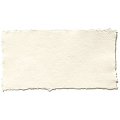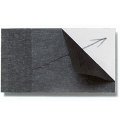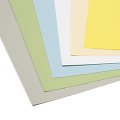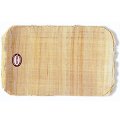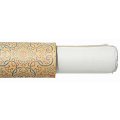Handmade paper
Information about handmade paper
Our hand-made paper comes from small paper mills where paper is produced as it was before the advent of industrialisation. For this purpose, fibres (usually cotton but also flax, hemp, etc.) are shredded in a so-called beater and thereby broken down into cellulose. This “fibre brew” (pulp) has water added to it and the resulting mass is then placed in a vat (hence, vat paper) and stirred vigorously so that the fibres are kept dispersed and form a suspension.
When making the paper, a mould (a frame with a wire mesh within it) is lowered into the vat containing the evenly distributed fibres and brought back out as soon as the mould is covered with the right amount of fibres for making a paper in the desired thickness. In a slightly different version of this process the watery fibre suspension is poured onto a mould which has been placed in a vat containing water and the fibres are then evenly spread across the mould. Every sheet of handmade paper is therefore always a unique creation having irregular (deckle) edges and slightly different sizes.
For the drying process the wet sheets are stacked between wool felt blotter sheets and subsequently compressed and then air dried. Depending on the planned use, the paper can then be sized after drying, then compressed and dried again so as to produce a surface that will have the right absorbency for water colours or some other medium. Paper with a rough untreated surface will take on the texture of the drying felt – this is referred to as the so-called “felt mark”. Matte paper is compressed between zinc plates and acquires thereby a smoother surface texture.
Khadi paper is made in India at the “Khadi Paper Mill”, which was jointly founded in 1994 by paper enthusiasts from England and local Indian partners in order to produce high-quality artist paper for the European market. Meanwhile, Khadi Paper is the only Indian paper mill capable of producing large handmade vat paper made from cotton rags that is good enough to satisfy high artistic standards. In 2005 the mill employed 50 workers from the immediate area. In addition, more jobs were created in numerous businesses which grew out of the delivery needs as well as the ancillary processing needs of the mill.
The Khadi mill also takes all the ecological issues that attend paper production very seriously and are extremely conscientious in dealing with them. The first of these concerns is water because paper production must use extremely large amounts of it – Khadi uses up to 40,000 litres daily. This water comes from their own well and is recycled up to 8 times before it is then used to water their own farmland. The fresh water is first used in the production of the white papers, then, after that, for the lighter colour tones and then for the dark colours. The final use of the water is for making other more basic types of paper.
It goes without saying that Khadi never uses any chlorine or bleaching agents. The dyes for the coloured paper come from European producers and comply with all the German and European environmental norms. Not only that, but all the paper is sized in bulk (in the vat) using pH neutral, synthetic size. White paper is given an additional surface treatment with gelatine in order to produce the perfect surface for water colours.
Khadi uses for its paper production only cotton cuttings which come from a local T-shirt manufacturer because using just such so-called “cotton rags” with their longer fibre enables better, more compact and sturdier varieties to be realized than could be achieved with the short fibred cotton linter which comes exclusively from cotton seeds. Please keep these signs of quality in mind when comparing Khadi paper with handmade paper made from cotton linter.
In contrast to the kinds of paper made from wood pulp (cellulose) that are often marketed with the claim “acid-free”, cotton based paper really is acid-free as long as it is not exposed to damaging environmental influences.
The given paper dimensions are only approximate because real handmade paper has irregular deckle edges on all four sides. In general, there is no running direction for handmade paper because the fibres in the vat are completely chaotic in solution and so are correspondingly chaotic in the sieve.
We specifically call your attention to these rarely appearing signs of quality because nowadays there are products sold under the name “vat paper” which are actually made by machine. Even the term “deckle edge” is often employed by other vendors to describe paper that is actually simply torn and thereby has a fibrous edge.
